lately
the on-line diary ofralph robert moore
www.ralphrobertmoore.com
the official website for the writings of ralph robert moore
Copyright © 2006 by Ralph Robert Moore. All rights reserved.
Return to lately 2007
You know how it happens, I'm not telling you anything new, you walk around your home in the middle of doing something else, come upon a weird object you've never seen before, but there it is, and you have no idea how it got there.
The object is carefully configured, suggesting it does have a function, but you have no clue what that function might be.
Here's the first of the objects we're going to consider.
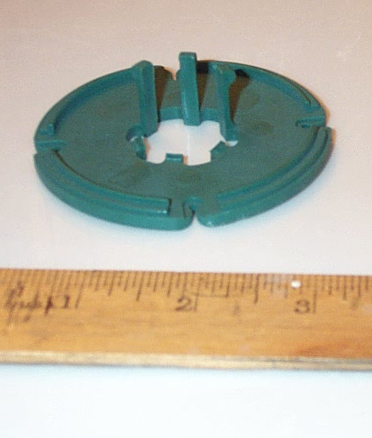
We found it on our garage floor, near the front rattle-up door, where we pile our black garbage bags, waiting for Tuesdays and Fridays.
Once we finally did get around to discussing this object ("What is that thing, anyway?"), we realized we had each been assuming it was something vital the other person knew about, so neither of us had thrown it out.
(In our defense, and in your defense, it is scary throwing away something that obviously serves some purpose, even if that purpose is entirely unknown. It's like all those dusty keys you have lying around your home. You don't know what they open, haven't picked one up in years, but what if you throw them out and two months later there's a small metal slit nothing on your keyring will slide into?)
The first photograph shows an "underside" view of the object, much like a cartoon horseshoe crab. Here's the top view:
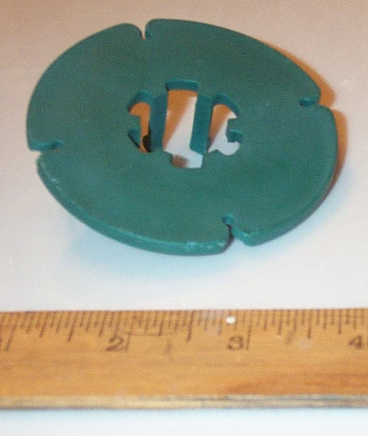
It's dark green, it's in our garage, so my first thought was it might have something to do with gardening. In my mind I conjured up, one after the other, our different gardening tools, but none had a component even remotely like this piece.
The three prongs on the bottom presumably snap onto something, securing this mystery in place, but onto what could they possibly snap?
There's no writing on the object, or symbols, even as simple a symbol as an arrow.
I don't have a clue. The piece itself is made of hard plastic, rather than pliable plastic. It's meant to be durable, to last a long time.
Is it from the future?
Maybe.
The size of it, its circular shape, would snap neatly into the crown of a person's skull, the toothy spaces in the middle sections perhaps meant to accommodate the corrugations of a large tube.
What would be the purpose of that tube?
Is it a feeding tube, or a vacuum?
Its bright color suggests that if people are forced into padded chairs at some point in the future, forearms and shins strapped against wood, toothy screams ignored, at least the big tube penetrating their brains is a cheerful color, meaning that even in the future, cheerfulness still counts.
Here's the next mysterious object:
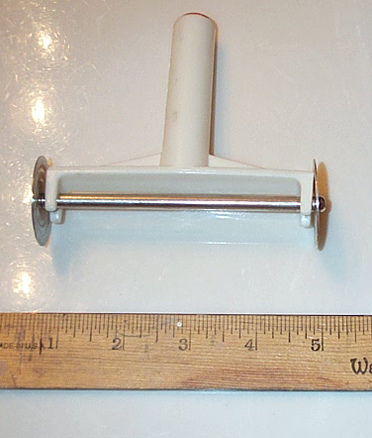
We have what appears to be a long handle, with rolling blades flanking a metal bar at the end of the handle.
The top of the handle is cherry red, as seen here:
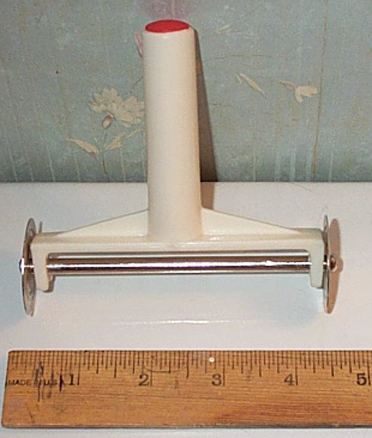
We found this in the catch-all drawer everyone has in their home, the one you slide out to dump in the latest unclassifiable object, thinking, I should really weed through this stuff some rainy day.
I don't know what the object is. I may have years and years ago, when I first opened the drawer, thinking, I'll put this in here, so it's safe. I'm thinking something to do with pasta, but really, the distance between the two rolling blades is too great for any pasta with which I'm familiar. The ensuing pasta would be bigger than my mouth, so I couldn't eat it. We tend to not eat food that would dislocate our jaws. Just watch any kitten continuously fang but ultimately reject (ultimately, like twenty minutes later, after hundreds of fang testings) a wobbly green grape.
I've rolled the device across my desktop, trying to figure out its use.
It's actually quite relaxing rolling this object, since through my fingers I feel the smoothness of its quiet rumble across my desk's wood.
Conclusion: It must be from the future. Conjecture: In the future, we might have a need for simple devices that help assuage our anxiety. Millions, perhaps billions, of people roll this wheeled device across a desk surface each morning.
Take a look at this thing:
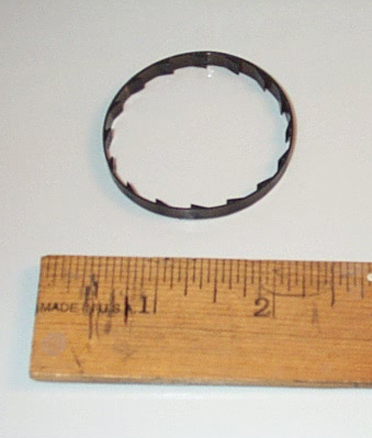
A circular device with nasty-looking barbs around the inner perimeter.
I'm thinking, sex toy?
But it looks kind of painful.
I realize some people consider pain to be an even more exquisite tactile sensation than pleasure, but I doubt there are enough of these visionaries in our neighborhood for a spare toy of theirs to show up in our home. At least, at the present time. Perhaps in the future…?
Finally, we have this:
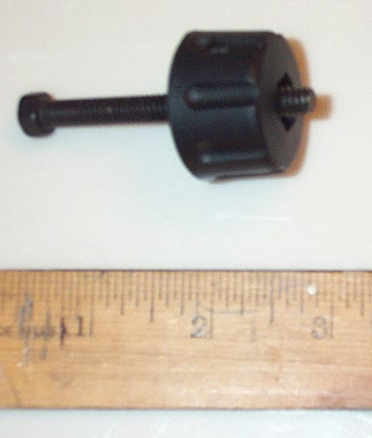
Frankly, I don't get it.
The device appears to have been created to show how a screw performs, but why the big head, and why is that head notched?
It doesn't look to me like the piece would be screwed-down onto another piece, because the screw is on the wrong side (i.e., the screw should be on the other, smooth side of the big head).
I'm at a loss.
Perhaps we are being sent a message from the future, and each weird object we find in our homes is one piece of an immense jigsaw puzzle it's urgently important we assemble.
I have trouble sleeping.
After Mary and I finish watching TV, we turn out the light.
I pull the covers over my shoulder. Close my eyes. The eternal optimist.
Spend the next half hour or so, on my stomach, switching my hips so they're left-leaning or right-leaning, head following the lean.
Finally, I fall under.
A couple of hours later, I'm awake.
Still on my stomach, I always first squint at the red diodes on my bedside clock, to see what time it is. If it's past midnight, I figure I'm doing pretty well. High five. Both my hands rising, slapping against each other above my spine. Metaphorically. If it's less than midnight, I know it's going to be a long night.
The worse thing you can do in the middle of the night is summon up something that worries you, so instead I try to focus on neutral thoughts.
The past half year, that's been space exploration. I try to envision a time when the moon is being colonized, in preparation to colonizing Mars, and Ceres.
(Ceres is a dwarf planet orbiting around the sun between Mars and Jupiter. Although it's significantly smaller than our moon, its ice mantle is believed to hold more fresh water than is present on Earth. In addition, its surface is relatively warm, about minus thirty-six degrees Fahrenheit, not bad for a planet 260,000,000 miles from the sun. A NASA spaceship launching later this year will rendezvous with Ceres for a close-up look in 2015, the first time Ceres will have been visited by us.)
Colonization is actually very much within our means right now.
One of the biggest concerns about living "off-Earth" is energy, but there's an extraordinary amount of solar energy outside the atmosphere of Earth, more than enough to generate whatever power would be needed. Solar ovens made of foil, for example, can create thousands of degrees of heat, at no cost. These ovens could be used to finance colonization efforts, their energy beamed to Earth via microwave.
Materials needed to create colonies are for the most part available on the satellite/planet being colonized (although our own moon lacks some volatiles, such as hydrogen, carbon and nitrogen), or "near-Earth objects" (NEOs), such as asteroids and comets. All we would really need to export from Earth are highly specialized products, such as circuits. Because of the low escape velocity of most planets/celestial objects, future planetary/satellite explorations could originate from an off-Earth colony, greatly reducing the fuel costs of interplanetary travel.
So the neutral thoughts I focus on in the middle of the night, face against my pillow, eyes shut, are entirely practical.
In my thoughts, the plan is to place several satellites in orbit around the moon, then land three spacecraft in close proximity to each other on the earth side (rather than the dark side) of the moon. Probably near one of the largest craters, where there's believed to be frozen water in the crater's shadow. Three landing crafts are used rather than one, because of the safety inherent in redundancies.
The three occupants of each craft then build three separate transparent domes, like little bubbles, adjacent to each other. Each dome covers an area about the size of a two-car garage.
The material of the dome has to be a material that will allow sunlight, be self-healing in the event of incoming space debris, and retain oxygen.
The second step of the colonization is to build a larger dome, encompassing land about equal to a football field.
Once this dome is completed, all nine astronauts move to that new area, vast in comparison to where they've been living. The three original habitats are retained, as a safe haven in case the larger dome runs into a problem (just as the three original landing craft are retained, in case they need to leave the surface).
More astronauts arrive, until we have twenty-seven in all.
Some will be devoted to scientific exploration, but most at this point will work on creating the first "true" moon colony, a habitat covered by a dome three miles in diameter.
Once this dome is created, the population on the moon will be increased to eighty-one.
It is at this point terra-forming will begin. Terra-forming is the importation of organic materials from the Earth to another celestial body in order to create a livable habitat. Terra-forming is ideal for the moon, because we know the moon is lifeless. We're not corrupting any biology already present. Terra-forming would not be appropriate, for example, on Mars, because we want to thoroughly examine that planet first to see if it has indigenous life before we start adding any. Terra-forming on Mars, hopefully, will not occur for several decades (the amount of time we'll need to thoroughly explore the planet for signs of past or extant life), and will not occur for several more decades if extant life is discovered.
The area enclosed by the three-mile dome is likely to encompass hills and valleys.
These hills and valleys will be planted with a hardy, highly-adaptable grass that reproduces rapidly, and is edible (think modified kudzu). The presence of this much plant life within the dome will increase oxygen levels. Once the grass is established, breaking down the soil, adding nutrients, small forests of fruit trees will be added (all transported from Earth as seeds).
A town will be established in the center of the dome. Moonbase buildings will be molded plastic, like the beautiful, elegant, rounded-sides plastic found within a side by side refrigerator's freezer half, around its ice-maker. All the buildings will be in pastel shades.
As the oxygen levels within the dome elevate, animals will be transported from the Earth to the moon. Chickens, definitely, all those fertilized white eggs jiggling in their protective foam on their journey; the clumped roe clusters of several different types of fish; and, eventually, calf embryos, for fresh milk, cheese, and beef.
Concurrent with the development of the first large dome, two others will be created adjacent to it, each three miles in diameter (why not simply create a dome nine miles in diameter? Again, the safety of redundancy, in case of emergencies such as a rupture or fire.)
If each dome initially holds eighty-one people, that means all three would hold 243 people. Once a second three-dome colony is established nearby, the moon's population will reach 486, close enough for the "50/500" rule advanced by Franklin and Soule (in essence, the idea that a population of fifty non-related humans is needed to prevent inbreeding, and a population of 500 non-related humans is needed to sustain genetic variability.)
But I'm getting ahead of myself.
Most nights, I fall asleep once the first three-mile dome is established, once it reaches the point where its imported plant life allows the astronauts to remove their helmets, shed their spacesuits and, for the first time ever, walk unencumbered on the surface of another body. Gathering outside their pastel plastic buildings, surrounded by green grass, distant orchards, seeing, beyond the shimmer of the dome's curve, the moon's original absolute gray, they must look into each other's eyes thinking, We're sleeping on God's front porch.
And those of us still on Earth?
The moon colony will be visible from Earth with a good pair of binoculars, decent amateur telescope. We could look up at the moon, see the little green bubbles and think, That's us up there.
Many of us write.
Is your writing male or female?
Now you can find out.
Go to The Gender Genie, paste in 500 words or more of a writing sample.
The instant analysis, as featured in The New York Times, will ascertain the degree to which your writing is male or female.
My own score was 694 female, 1134 male.
What's your score?